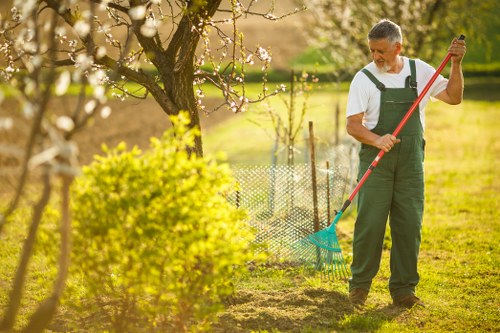Grass Cutting Woodlands

Introduction to Grass Cutting in Woodlands
Grass cutting in woodlands is essential for maintaining healthy ecosystems and ensuring the safety and aesthetics of these natural areas. Regular maintenance helps prevent overgrowth, reduce fire hazards, and promote biodiversity.
Woodlands provide habitats for various species, and proper grass cutting techniques can support the balance between human activities and wildlife conservation.
Understanding the best practices for grass cutting in woodlands can lead to more sustainable and effective landscape management.

Benefits of Regular Grass Cutting
Health of the Ecosystem
Regular grass cutting promotes the health of the woodland ecosystem by preventing the overgrowth of invasive species and allowing native plants to thrive.
Maintaining open areas helps sunlight reach the forest floor, which is crucial for the growth of various understory plants.
Proper grass management can also enhance soil quality and reduce erosion.
Fire Prevention
Overgrown grass can be a significant fire hazard in woodlands. By keeping grass levels low, the risk of wildfires can be minimized.
Regular cutting removes dry vegetation that can easily ignite, thus protecting both the woodland and surrounding communities.
Implementing grass cutting schedules during dry seasons is particularly effective in fire prevention.

Grass Cutting Techniques
Mechanical Cutting
Mechanical grass cutting involves using machinery such as mowers and trimmers to maintain grass levels. This method is efficient for larger areas and ensures uniformity.
Benefits include time savings and consistent results, but it's essential to use eco-friendly equipment to minimize environmental impact.
Manual Cutting
Manual grass cutting uses tools like scythes and shears, which are more labor-intensive but offer greater control over the cutting process.
This method is ideal for smaller areas or sensitive environments where machinery might cause damage.
Manual cutting also allows for selective removal of specific plants, promoting biodiversity.
Selective Cutting
Selective cutting targets specific areas or types of grass, reducing the impact on the overall woodland.
This approach helps preserve native plant species and maintains the natural structure of the woodland.

Equipment and Tools
Choosing the Right Tools
Selecting appropriate equipment is crucial for effective grass cutting in woodlands. Factors to consider include the size of the area, terrain, and environmental sensitivity.
Electric mowers are quieter and more environmentally friendly compared to gas-powered ones, making them suitable for sensitive areas.
Maintenance of Equipment
Regular maintenance of grass cutting tools ensures their longevity and efficiency. This includes sharpening blades, cleaning parts, and checking for wear and tear.
Proper maintenance reduces the likelihood of equipment failure and promotes safe operation.

Local Relevance: Woodlands Around You
Understanding the local woodlands near you can help tailor grass cutting practices to suit specific environmental conditions.
- Greenwood Park: Located 2 miles north, known for its tall oak trees and diverse bird species.
- Maple Grove: 3 miles east, features dense underbrush ideal for wildlife.
- Pine Ridge: 4 miles southwest, has rocky terrain requiring specialized equipment.
- Silver Lake Woodlands: 5 miles west, close to water bodies, necessitating careful grass cutting to protect aquatic life.
- Birchwood Trail: 6 miles northeast, popular for hiking and requires regular maintenance to keep trails clear.
- Cedar Haven: 7 miles southeast, offers scenic views and benefits from selective grass cutting.
- Elm Forest: 8 miles northwest, known for its spring wildflowers, requiring timed grass cutting to preserve blooms.
- Willow Creek: 9 miles southwest, has areas prone to flooding, needing strategic grass management.
- Oak Meadow: 10 miles northeast, expansive grasslands within the woodland that require periodic mowing.
- Aspen Grove: 11 miles east, specialized grass cutting to support the unique aspen trees.
Environmental Considerations
When cutting grass in woodlands, it's essential to consider the environmental impact. Minimizing disruption to wildlife and preserving natural habitats should be top priorities.
Using eco-friendly equipment and adopting sustainable practices ensures that grass cutting activities do not harm the ecosystem.
Implementing buffer zones and avoiding critical breeding seasons for wildlife are also important strategies.
Sustainable Practices
Adopting sustainable grass cutting practices involves reducing chemical usage, conserving water, and promoting natural plant growth.
Techniques such as mulching and composting grass clippings can enhance soil fertility without harmful additives.
Wildlife Protection
Protecting wildlife during grass cutting requires careful planning and execution. This includes scheduling cutting activities during times when wildlife is less active.
Fencing off sensitive areas and creating refuges can help maintain safe habitats for animals.
Community Involvement
Engaging the local community in grass cutting initiatives fosters a sense of ownership and responsibility towards woodland conservation.
Volunteer programs and educational workshops can raise awareness about the importance of maintaining healthy woodlands.
Collaborative efforts between residents, organizations, and authorities enhance the effectiveness of grass cutting activities.
Volunteer Programs
Organizing volunteer groups for grass cutting can provide manpower and promote community bonding. These programs often involve scheduled clean-up days and maintenance events.
Educational Workshops
Educational initiatives teach community members about sustainable grass cutting techniques and the ecological benefits of maintaining woodlands.
Tools and Techniques for Effective Grass Cutting
Choosing the Right Equipment
Selecting appropriate tools ensures efficient grass cutting and minimizes damage to the woodland environment. Electric mowers are preferred for their lower environmental impact, while manual tools like shears offer precision in sensitive areas.
Proper Cutting Techniques
Adopting the correct cutting height and pattern can promote healthy grass growth and prevent soil erosion. Avoiding cutting too short helps maintain moisture levels and supports ground cover.
Safety Measures
Implementing safety measures during grass cutting is crucial to prevent accidents and injuries. This includes wearing protective gear, maintaining equipment, and being aware of surroundings.
Training for individuals involved in grass cutting ensures that they are knowledgeable about safe practices and emergency procedures.
Protective Gear
Wearing appropriate clothing, gloves, and eye protection minimizes the risk of injury while operating grass cutting tools.
Equipment Maintenance
Regularly inspecting and maintaining equipment prevents malfunctions and ensures safe operation during grass cutting activities.
Challenges in Grass Cutting Woodlands
Maintaining grass in woodlands presents several challenges, including difficult terrain, unpredictable weather, and balancing human needs with ecological preservation.
Addressing these challenges requires flexibility, proper planning, and the use of appropriate tools and techniques.
Difficult Terrain
Uneven ground, steep slopes, and dense vegetation can make grass cutting labor-intensive and time-consuming.
Unpredictable Weather
Weather conditions such as rain and wind can hinder grass cutting efforts and affect the efficiency of maintenance activities.
Local Regulations and Guidelines
Adhering to local regulations and guidelines ensures that grass cutting activities comply with environmental laws and community standards.
Understanding zoning laws, protected areas, and permissible times for grass cutting helps avoid legal issues and promotes responsible land management.
Compliance with Environmental Laws
Being aware of and following environmental legislation related to woodland maintenance prevents violations and supports conservation efforts.
Community Standards
Aligning grass cutting practices with local community expectations fosters goodwill and cooperation in woodland management projects.
Innovations in Grass Cutting
Advancements in technology have introduced new methods and tools for more efficient and sustainable grass cutting in woodlands.
Electric and battery-powered mowers reduce emissions, while robotic mowers offer automated solutions for regular maintenance.
Eco-Friendly Equipment
The development of solar-powered and battery-operated grass cutting tools minimizes the environmental footprint of maintenance activities.
Automated Systems
Robotic mowers provide consistent and precise grass cutting with minimal human intervention, enhancing efficiency and reducing labor costs.
Conclusion
Grass cutting in woodlands is a vital practice for preserving the health and beauty of these natural areas. By adopting sustainable techniques, using appropriate tools, and engaging the community, effective grass management can be achieved without compromising the ecosystem.
Balancing human needs with environmental conservation ensures that woodlands remain vibrant and flourishing for generations to come.
Frequently Asked Questions
1. How often should grass be cut in woodlands?
Grass cutting frequency depends on factors like grass growth rate, season, and specific woodland conditions. Generally, mowing 2-4 times a year is recommended to prevent overgrowth.
2. What tools are best for grass cutting in sensitive woodland areas?
Manual tools like shears and electric mowers are ideal for sensitive areas as they minimize disturbance to the environment and wildlife.
3. Can grass cutting negatively affect woodland ecosystems?
Improper grass cutting can disrupt habitats and reduce biodiversity. It’s important to use sustainable practices to protect the ecosystem.
4. Are there any regulations for grass cutting in woodlands?
Yes, local regulations may dictate when and how grass cutting can be performed to ensure environmental protection and compliance with zoning laws.
5. How can the community get involved in grass cutting efforts?
Community members can participate in volunteer programs, attend educational workshops, and collaborate with local organizations to support grass cutting initiatives.

